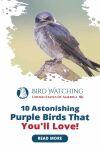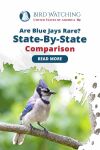
What’s This Post About?
Purple birds are found in many different species around the globe. In the US, you may come across as many purple birds with different shapes and sizes. In addition, some birds may have a dark shade of purple on them, while some birds may be of a dull purple tone.
Colored birds are considered one of the most beautiful creatures found worldwide, primarily because of their plumage.
This post consists of a list of birds with a purple plumage; it is interesting to note that most purple-colored birds seen frequently are males, while the female counterpart of the same species may differ in color and shades.
There are many types of purple birds found in the US. Some common birds that you may come across in this region are purple martin, varied bunting, purple finch, purple gallinule, purple honeycreeper, purple sandpiper, purple swamphen, violaceous jay, violet-crowned woodnymph, and purplish jay.

What Kind of Birds Are Purple-Colored?
Let’s start by listing the names of 10 birds that are found in the shade purple. Some birds may appear different when seen from a distance, but as you observe them from a close eye, you will be mesmerized by their majestic beauty. The list is as follows:
-
Purple Martin
-
Purple Gallinule
-
Varied Bunting
-
Purple Honey Creeper
-
Violet-Crowned Woodnymph
-
Purple Finch
-
Purplish Jay
-
Violaceous Jay
-
Purple Swamphen
-
Purple Sandpiper
Fun Fact
There are approximately 10,000 different bird species worldwide.
1. Purple Martins

Purple Martins are similar to large swallows. They are known for their fast-flying abilities, where they portray a mixture of gliding and flapping.
These species feed in midair, where they catch insects flying around, for example, dragonflies. Purple martins tend to roost and feed in flocks. Since they are colonial birds, the martins usually nest together in the same spot.
In the West, you may find purple martins nesting in natural cavities, while in the East, they look for open areas near the water to feed on and martin houses or nest boxes to nest in.
Fun Fact
House sparrows and starlings aggressively force purple martins to move out of the local areas by taking over their nesting sites.
- Appearance
To figure out what a purple martin looks like, you need to keep the following pointers in mind:
- Broad chest
- Forked and short tails
- Slightly hooked and stout bills
- Long brown-black wings
- Dark purple bluish plumage
- Females are duller with gray heads and white chests
Pro-Tip
Place eggshells in your backyard to help purple martins digest the insects they consume.
2. Purple Gallinule

Purple Gallinules are large birds with a size similar to a crow. They belong to the rail species and are commonly known as the yellow-legged gallinule. Gallinules like to forage near water bodies where they feed on aquatic vegetation.
Taking advantage of their long legs, purple gallinules usually perch high on trees and bushes. During the nesting period, these birds like to nest near freshwater sources such as ponds.
Fun Fact
Babies of purple gallinules can walk around as soon as they hatch, but they cannot feed themselves.
- Appearance
To figure out what a purple gallinule looks like, you need to keep the following pointers in mind:
- Chicken-sized rail
- Conical, yellow-tipped bill
- Short, cocked tail
- Very long bright yellow legs and toes
- Purple body and head
- Greenish wings
- Young gallinules are brownish with duller legs and bill
Pro-Tip
Placing water sources like a small pond in your backyard can attract purple gallinules.
3. Varied Bunting

Varied Buntings are small dainty songbirds. They are Mexican species with a mixture of crimson, purple, red, and violet plumage. You may rarely see a varied bunting flying around since these birds try to avoid populated areas.
Varied buntings primarily feed on dense vegetation, insects, and sometimes cactus seeds or fruits. Buntings prefer to nest in forests, stream corridors, and desert areas.
Interesting Fact
A group of buntings flocking together is called ‘decoration,’ ‘mural,’ or ‘sacrifice.’
- Appearance
On rare instances, if you spot a bird that looks like a varied bunting, you may run through the following list to be sure about your stance:
- Forked tail
- Short conical bill with a slight curve
- A body with a mix of red and purple shades
- The upper body is crimson with a bluish-purple face and shoulders
- A thick black ring around the bill
- Females have a grayish-brown plumage
Interesting Fact
Snow bunting is the most brightly colored bird amongst all the bunting species.
4. Purple Honeycreeper

A purple honeycreeper is a tiny bird belonging to the Tanager family. Honeycreepers are 45 inches long and weigh 0.42 oz. These birds are known for their active, acrobatic skills. The male honeycreeper is purple with a unique long bill.
Purple honeycreepers are found commonly in foothills and lowlands of northern South America and are frequent visitors of woodlands and gardens.
Interesting Fact
The call of a purple honeycreeper is a high-pitched, thin sound.
- Appearance
You can look for the following features if you are looking to identify a purple honeycreeper:
- The male is purple with black wings, stomach, and tail
- Short bright yellow legs
- Long decurved bill
- Black mask in front of the eyes
- Females are more of a greenish tone with duller parts
Pro-Tip
Purple honeycreepers are attracted to nectar, insects, and berries.
5. Violet-Crowned Woodnymph

The violet-crowned woodnymph is a medium-sized hummingbird found in the US. There are many different colored birds within the same species. They are primarily located in foothills and wet lowlands. The male measures 4 inches in length and weighs approximately 4.5 grams.
The female woodnymphs are shorter than the males and weigh less, too. These birds do not migrate or nest in flocks.
The male woodnymph takes part in only the mating process and can mate with several other female birds. However, the female is responsible for building the nest, choosing the right location, and raising the young.
Fun Fact
The male violet-crowned woodnymph separates from the female instantly after copulation.
- Appearance
To be sure that the bird in your backyard is a violet-crowned woodnymph, you can take a look at these features:
- Violet crown on the shoulders, abdomen, and back
- Shiny green plumage on the throat and breasts
- A short forked, blue-black tail
- Females are bright green on the upper body and dull green on the lower sides
Interesting Fact
Woodnymphs prefer flowers with the highest sugar content, specifically red-colored flowers or those with a tubular shape.
6. Purple Finch

Purple finches are common small forest birds about the size of a sparrow. During the breeding season, they are primarily seen in mixed coniferous and deciduous woods. In the winter season, they seek shelter in old fields, forest edges, and backyards.
The finches consist of a range of birds such as a house finch, common chaffinch, European goldfinch, etc. These birds usually have a lifespan of 3 to 4 years.
Fun Fact
Purple finches were famously described as ‘sparrows dipped in raspberry juice.’
- Appearance
The captivating beauty of purple finches can be recognized from a distance. To know about their unique features, read the points below:
- Large and chunky body structure
- Medium-sized conical beaks
- A notched-up short brownish tail
- Males are a mixture of crimson, purple, and rosy-pink hues
- Hints of brown on the back and a white belly area
- White mask in front of the eyes
- Dark line on the side of the throat

Pro-Tip
Backyard feeders are great to attract finches.
7. Purplish Jay

The purplish jay birds belong to the crow family. These birds are found in groups near forest canopies or the edge of forests. They have a low yet harsh sound. Purplish jays have a deep dull coloring and are very vocal.
The natural habitats of purplish jays are tropical or subtropical forests and moist lowland forests. These birds are mostly between 14 to 16 inches in length.
- Appearance
Purplish Jays may come across as dark blackbirds if seen from a distance. However, their deep color is different. Look out for the following points:
- Deep purplish-blue coloration
- Dark purple-black head
- A tiny, ruffled crest on the head
- The underside of the wings and tail are black
- A short black beak
8. Violaceous Jay

Violaceous Jays are bird species that belong to the Corvidae family. These medium-large birds are omnivorous and depend on fruits, insects, and bird or reptile eggs to survive. The violaceous Jays have a dull plumage and are 13 to 15 inches long.
The natural habitat of these violet birds is tropical or sub-tropical lowlands. These noisy birds forage in flocks and are known to mob other predators. To watch and observe these species, you can invest in Zeiss Terra ED Binoculars.
Zeiss Terra ED Binoculars
Glass with a hydrophobic multi-coating provides optical clarity and precision in all situations.
Fun Fact
Jays are skilled at mimicking other animals and birds.
- Appearance
To recognize a violaceous jay, you should study its features. A few of the features are listed below:
- Vibrant purplish-blue plumage
- Deep black head and a black bib on the throat
- Short, pointed beak
- White hues on the chest and back
- Black short legs with long toes to grasp on tree branches
Interesting Fact
In the 19th century, jay feathers were trendy as they were worn as accessories.
9. Purple Swamphen

Purple Swamphen is large wetland species. They are primarily found in groups during the breeding season. Purple swamphens are bulky birds mostly found near water edges, reeds, and floating vegetation.
These birds are skilled swimmers and can also take flight if they sense any danger. Purple swamphens like to feed on soft shoots and small animals such as snails and frogs.
Fun Fact
There are six species under the swamphen family.
- Appearance
Purple Swamphens are significant; there is no way you can not recognize this creature. The unique features of this species are:
- Dusky black upper body
- Broad dark purplish-blue collar
- Deep purplish-blue lower body
- Red and robust bill
- Orangish-red feet and legs
- Red eyes
- Redline on the head
Fun Fact
The purple swamphen holds food with its long toes while eating.
10. Purple Sandpiper

A purple sandpiper is a pot-bellied shorebird that prefers to forage primarily on ocean coasts. They like to feed on seaweeds and aquatic invertebrates found along shorelines.
Purple sandpipers tend to spend their winters on rocky ocean coasts. These birds are approximately 7 to 9 inches in length and weigh 50 to 105 grams.
Fun Fact
The oldest purple sandpiper lived for approximately twenty years and nine months.
- Appearance
The look of the purple sandpiper is much different than its name. The color of these birds is mostly brownish-gray with faint hints of purple. Other features include:
- Long, slightly drooping orange bill with a black front
- Long orange legs
- Grayish plumage on the upper body
- White belly area with dark speckles on the breast
- Short grayish wings with brown speckles
- Shoulder feathers have a reddish-brown shade
- Hard to see violet shade on the wings of non-breeding adults
Pro-Tip
Purple sandpipers may come across as brownish gray at first sight.
Keep Reading
This post consists of all the exquisite, purple-colored birds you may see or spot in your region. There are various beautiful bird species, with a range of different colors, present on earth. Watching them or reading about them can be a great hobby.
The purple birds discussed above are of different shapes and sizes. They vary in appearance, behavior and have other habitat preferences.
If you are interested in reading about other colored birds, you can read through this post to learn about birds with red heads.
13 Astounding Birds with Red Heads With Pictures! (Backyard Friendly)
Wondering what type of red-headed bird just fluttered by you in your backyard? It’s not as easy to figure out as you’d think. There are quite a few!

By David A. Swanson
Bird Watching USA
My name is David and I'm the the founder of Bird Watching USA! I started Bird Watching with My father-in-law many years ago, and I've become an addict to watching these beautiful creatures. I've learnt so much over about bird watching over the years that I want to share with the world everything I know about them!

David A. Swanson
Bird Watching USA
My name is David and I'm the the founder of Bird Watching USA! I started Bird Watching with My father-in-law many years ago, and I've become an addict to watching these beautiful creatures. I've learnt so much over about bird watching over the years that I want to share with the world everything I know about them!








